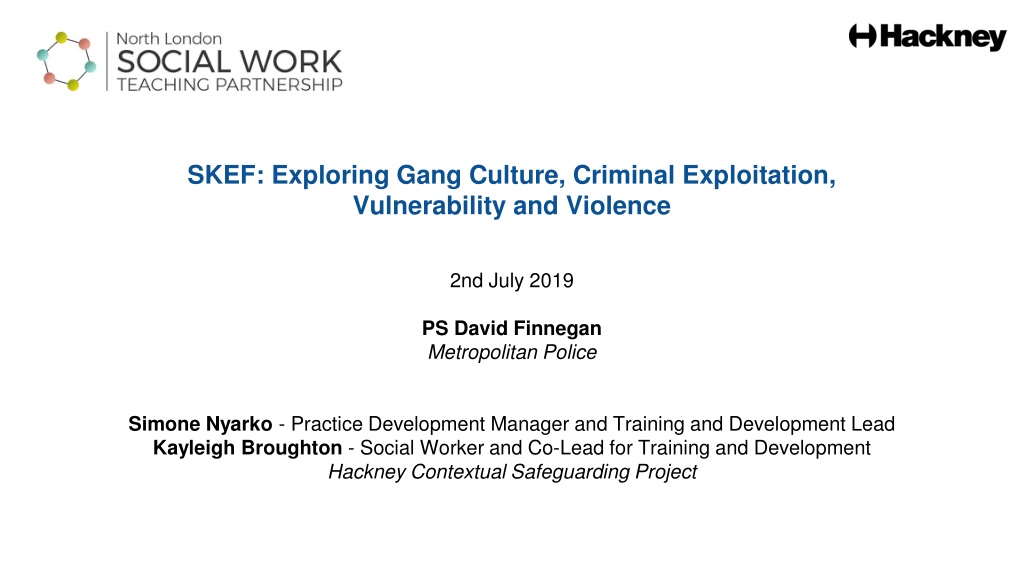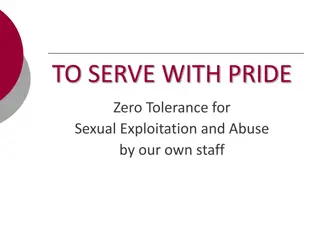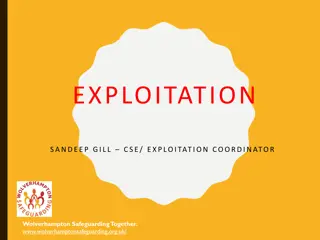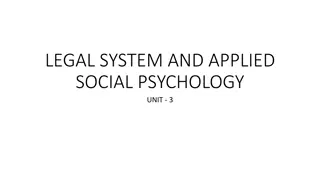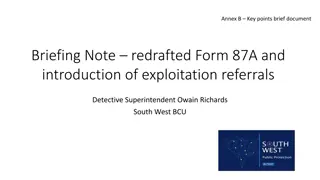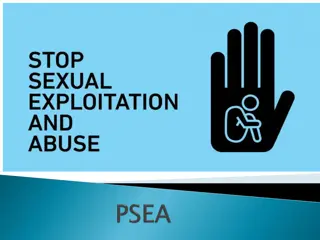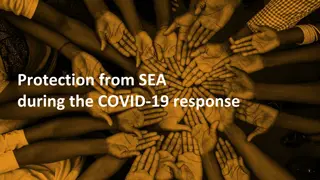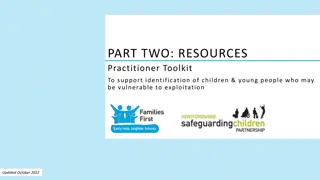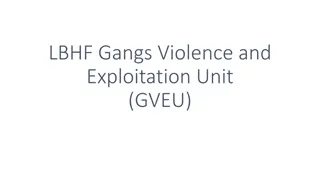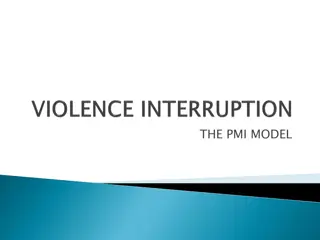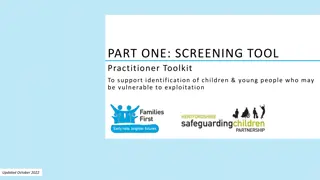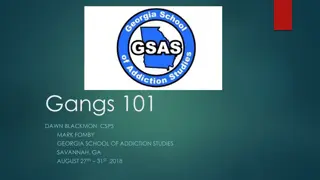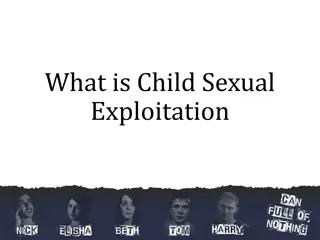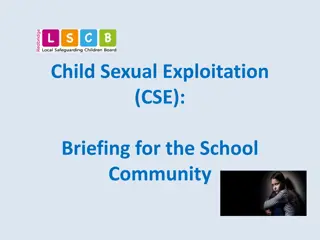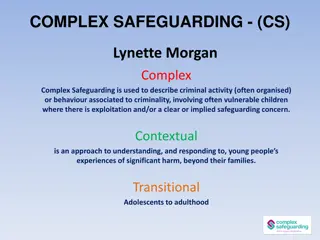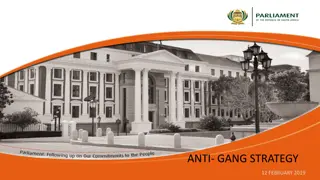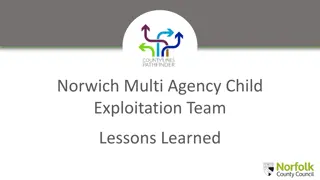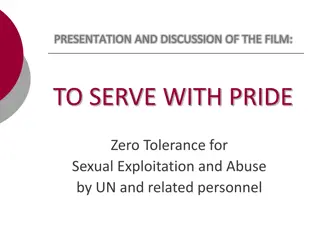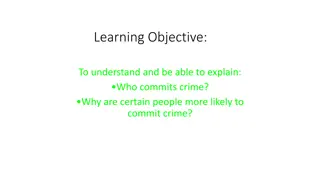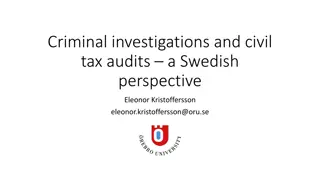Understanding Gang Culture and Criminal Exploitation - Session Insights
This session delves into the complexities of gang culture, criminal exploitation, vulnerability, and violence. Attendees will learn about identifying susceptibility to exploitation, recognizing early warning signs in child protection work, and implementing effective responses to criminal exploitation for aiding recovery. Engage in interactive quizzes to test your knowledge on police procedures, County Lines operations, and missing person investigations in London.
Download Presentation

Please find below an Image/Link to download the presentation.
The content on the website is provided AS IS for your information and personal use only. It may not be sold, licensed, or shared on other websites without obtaining consent from the author. Download presentation by click this link. If you encounter any issues during the download, it is possible that the publisher has removed the file from their server.
E N D
Presentation Transcript
SKEF: Exploring Gang Culture, Criminal Exploitation, Vulnerability and Violence 2nd July 2019 PS David Finnegan Metropolitan Police Simone Nyarko - Practice Development Manager and Training and Development Lead Kayleigh Broughton - Social Worker and Co-Lead for Training and Development Hackney Contextual Safeguarding Project
Session objectives: Understand what may make a young person or vulnerable adult more susceptible to exploitation Participants to consider early warning signs that social work staff should be aware of in child protection work Participants will consider what is needed from services to respond effectively to criminal exploitation and aid recovery
Introductory Quiz: How long can a Police Officer keep a child in Police Protection? A. 48 Hours B. 72 Hours C. As long as necessary What is the lowest rank that can make the decision to take a child into Police Protection? A. PC B. Inspector C. Chief Inspector
Introductory Quiz: When someone is arrested where does the law state they should be brought to? A. A Purpose Built Custody Suite B. A Designated Police Station C. Any suitable place What is the lowest rank that the law states can decide to detain someone at a Police Station after arrest? A. PC B. Sergeant C. Inspector
Introductory Quiz: Approximately how many County Lines do the NCA state are currently active across England & Wales? A. 320 B. 510 C. 720 How many of those are estimated to be running from London? A. 113 B. 283 C. 396
Introductory Quiz: Who is responsible for investigating a Missing Person Report of a LAC moved away from the area to somewhere else in London? A. BCU where they now live B. BCU where they have been moved from C. Co-ordinated approach from both BCU s What department is responsible for investigating Low and Medium Risk Missing Persons for the first 48 hours? A. Missing Persons Unit B. Emergency Response Team C. No investigation takes place until Missing for 48 hours
Introductory Quiz: How long can a Police Officer keep a child in Police Protection? A. 48 Hours B. 72 Hours C. As long as necessary What is the lowest rank that can make the decision to take a child into Police Protection? A. PC B. Inspector C. Chief Inspector
Introductory Quiz: When someone is arrested where does the law state they should be brought to? A. A Purpose Built Custody Suite B. A Designated Police Station C. Any suitable place What is the lowest rank that the law states can decide to detain someone at a Police Station after arrest? A. PC B. Sergeant C. Inspector
Introductory Quiz: Who is responsible for investigating a Missing Person Report of a LAC moved away from the area to somewhere else in London? A. BCU where they now live B. BCU where they have been moved from C. Co-ordinated approach from both BCU s What department is responsible for investigating Low and Medium Risk Missing Persons for the first 48 hours? A. Missing Persons Unit B. Emergency Response Team C. No investigation takes place until Missing for 48 hours
County Lines DEFINITION: A system used by criminals based in cities to supply drugs in smaller towns & rural areas. Name used refers to a single phone line used by a particular gang. Organisers operate from a distance outside the affected area using vulnerable people to deliver drugs and move money. Usually the lines are re-supplied from their home area.
Why Have They Developed MPS have developed an extensive Gangs Strategy and most significant members of the Gangs have been identified County Forces are still developing these strategies due to it being a new issue Numbers of officers in County Forces do not match the MPS Staging areas have been created through re-housing Risk to their business is greatly reduced, easier to move around and increases their client base Altercations with rival gangs are avoided
Background - DfE Innovation Bid Hackney Safeguarding approach. awarded DfE innovation bid to develop a Contextual Two year project in partnership with the University of Bedfordshire (UoB) Supported through a Contextual Safeguarding project team including Hackney staff and researchers from the UoB. Aim to develop interventions to identify and intervene with extra-familial risks, working with the wider context in which these risks arise.
Theoretical framework: Bourdieu https://www.contextualsafeguarding.org.uk/audit-toolkit/introduction/theoretical-underpinning
The Scale of Peer-on-Peer Abuse 1/3 identified cases in England and Wales, 55% in London Recorded cases of children committing sexual offences against other children have risen by 78% in England and Wales between 2013 and 2016 (Barnardo s, 2017) When surveyed, a quarter of girls and 18% of boys report experience some kind of physical violence from a partner (Barter, et al., 2009) Between 30 and 70% of young women report encountering sexual harassment in school (EVAW, 2010; GirlGuiding UK, 2014) 10-15 year olds in 2013 were estimated to have experienced 465,000 incidents of violent crime, 79% of which had been perpetrated by someone also aged 10-15 (ONS, 2015) A survey of adult survivors of child sexual abuse in England in Wales in 2011 founds that around two thirds had been abused by a young person and not an adult (Radford, et al., 2011).
Defining Peer-on-Peer abuse Physical, sexual, emotional and financial abuse, and coercive control, exercised within young people s relationships
Seeing the signs Consistently being reported missing Distrust of authorities or acting as if instructed by someone else Stopped by other police forces some distance away from their home area Appear to not know the local area when questioned Expressions of fear/anxiety and/or lack of medical care In possession of train tickets/burner phones/addresses/phone numbers Injuries resulting from assault or controlling measures Gang members that have been moved appearing back in the London area Passport or other documents being held by someone else Someone else buying their food for them on a regular basis as payment Identifying factors from other investigations
Seeing the signs. Parental concerns Suspicion of physical assault / unexplained injuries Regularly going missing from school or home and / or being found out-of-area Carrying weapons Unexplained money, clothes, or mobile phones Significant decline in school results / performance and attendance Threatening to harm self or others in the home if prevented from leaving Gang association or isolation from peers or social networks Excessive receipt of texts / phone calls Self-harm or significant changes in emotional well-being Relationships with controlling / older individuals or groups Leaving home / care without explanation.
Quality Assurance: Challenging Language Promiscuous Sexually aware / experienced Glamour Manipulative Not safeguarding her/himself Will not engage Streetwise Unfaithful Risky choices/behaviour Aggressive Lifestyle choices Out of control Putting themselves at risk Liar Absconder Boys being boys
Suspect vs Victim Drug Dealers use vulnerable children/adults to protect themselves Creates a hard choice between treating them as a suspect or as a victim Defence of Duress and the follow on problems CPS Direction that Police should take a more balanced approach Instead of immediate disposal, the child/vulnerable person should be bailed/RUI so more information can be sought from partner agencies as unlikely to have this information while they are in custody
Victim vs. Perpetrator Narrative from a child protection social work perspective
Modern Slavery Modern Slavery Act 2015 (MSA) 3 Main Offences (Repeals Other Law) 1. Slavery, Servitude and Forced or Compulsory Labour 2. Human Trafficking for Purpose of Exploitation 3. Committing an Act with Intent to Commit the Offence of Human Trafficking (False Documents/Transporting People) Where there is indications on HT, Police should record a crime report and also make a referral to the NCA via the National Referral Mechanism (NRM) Over 18 Must have their consent Under 18 No consent is needed Where a decision is made to charge offenders for drug offences, it is very difficult to reverse that decision in order to bring Human Trafficking charges against real offenders CPS
Modern Slavery S.45 MSA 2015 Defence when compelled to commit the crime If you BELIEVE they are a victim of modern slavery More than suspicion Should be released immediately and safeguarding measures implemented Over/Under 18 is irrelevant just that they committed the offence and it was a DIRECT consequence of them being a victim of trafficking or slavery. Opportunity to stop the act and get help Balance of Probability Test not Beyond Reasonable Doubt Test Once classed as a victim, no requirement to then give evidence.
Modern Slavery S.45 MSA 2015 Defence when compelled to commit the crime Certain Offences this does not apply to 1. 2. 3. 4. 5. 6. 7. 8. False Imprisonment/Kidnapping Murder/Manslaughter Serious Assaults Firearms Offences Robbery/Burglary Perverting the Course of Justice Piracy Other Offences listed in Schedule 4 of the Act
Modern Slavery Conviction Operation Lindvi March 2017 County Line identified operating between London and Swansea Joint operation with South Wales Police identified the address being used During the search a vulnerable 19 year old woman was found who had been reported missing from her home in London Driven to Wales and her phone destroyed Told You belong to me now Held at the address for 5 days and forced to hold drugs and deal for them Police proved that two men were running this operation and had trafficked the woman to the area in order to exploit her Both pleaded guilty to the offence at Court and were sentenced ONLY REASON THE COURT CASE WENT AHEAD WAS DUE TO THE VICTIM SUPPORTING THE PROSECUTION.
Case Studies 1. Approaching Young People in the Area Territory and Historical Gang Areas 2. Creating Drug Debts Planned Deliveries and Robberies 3. Identifying Family and Home Addresses Sending Messages through Family Members 4. Organised Drug Drop Deliveries Dead Drops 5. Tasking Younger Members/Initiation Acts Identifying Other Dealers and Attacking Them
Family history and background Paul Jnr is 16 Laila, Paul s mother is parenting alone after the parents relationship of 17 years broke down a year ago. There have been reports of continuous arguing about co-parenting, finances and housing. Both parents deny domestic abuse. Paul has a relationship with his father Paul Snr and he sees him once a week at the weekend.
Home Life Paul, age 16 - Paul previously had a good relationship with his mother, but of late he has become rude and frequently tells her that he does not need to listen to her rules and that he will be moving out soon because he is 16 and she cannot tell him what to do. Paul has put a lock on his bedroom door several times; he says that this is to stop his siblings going into his room and through his stuff. Mother has removed it, but each time he puts it back. Paul has started to stay out after his curfew, he is being brought home in cars and has also been returned home by the police after being found in possession of a knife on two occasions. He was referred to Prevention and Diversion after admitting the first offence but received a Referral Order for the second offence, which is nearing completion. Although he did not attend all of his appointments he has developed a good relationship with his Youth Offending Team worker. Paul has been warned that a further offence is likely to result in a custodial sentence. Last week Paul was out for four nights. On the first night mum called him and he answered the phone, saying he was staying at his friend s house. When mum asked to speak to the adult in the home the call was disconnected and she was not able to get back in touch with him. Mum called the Police but they advised that he was not missing as she had spoken to him. Paul returned home on the fifth evening at 10pm. He told mum that his battery had died and they argued. Mum has told you that Paul s response was more aggressive than usual and she thought he might hit her but he did not.
Education Paul, age 16 - Paul has had difficulties with his behaviour in school from a young age. When he was in primary school his mother was often called in to calm him down or asked to come and collect him due to him hitting teachers and other children. Paul s difficulties persisted in secondary school. Individual pastoral staff have offered his parents a sympathetic ear about his behaviour and some staff had expressed to his mum that they are worried about how the school had been managing him. The school had offered counselling which Paul had started to attend, however, this ended when he was permanently excluded following the first knife incident. He now is on roll at the Pupil Referral Unit but only has lessons three days a week. Paul sometimes skips days at his education provision.
Neighbourhood Laila, mother - Laila and her family have lived in the same neighbourhood since she was a teenager and moved out of her parents home, but remained living locally. Laila has a good set of friends who support her. Laila also went to the local secondary school.
Neighbourhood (cont.) Paul, age 16 - Laila has told you the one of her friends has informed her that she has seen Paul hanging out on the street with older boys at whilst she is at work. Mum has not been particularly worried about this as some of the children she has seen him with are the sons of her friends. Mum does not know some of the males in the group
The Incident Laila calls you to update that Paul has just left the house after she overheard him on the phone saying that he is going to deal with it . Laila says that she asked him what he was talking about but he refused to say. Laila tried to prevent him from leaving by standing in front of the door but he pushed her out of the way. Laila saw him get into a car that appeared to have been waiting for him outside. Laila is calling because e is worried because she suspects Paul has removed a knife from the kitchen. Paul is currently not at home. Mum spoke to him this afternoon and he said he would be staying at a friend s. He is not currently answering mum s calls.
Discussion 1. What are the risks? 2. What would you do? 3. Who would you ask for help? 4. At what point could / should someone have intervened earlier? 5. How can services consider recovery in our responses?
For more information Contact the project team at: Contextual.safeguarding@hackney.gov.uk Join the Contextual Safeguarding network at: www.contextualsafeguarding.org.uk Contact PS David Finnegan at: david.finnegan@met.pnn.police.uk
